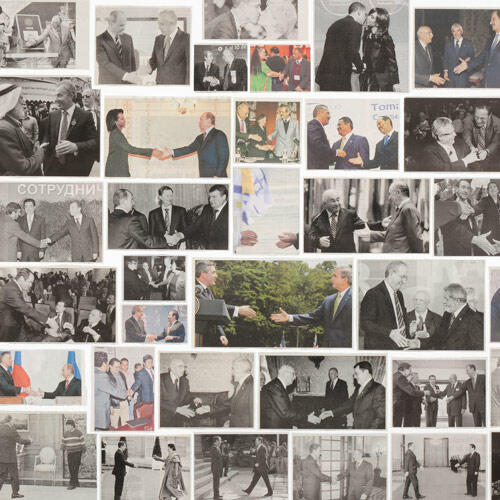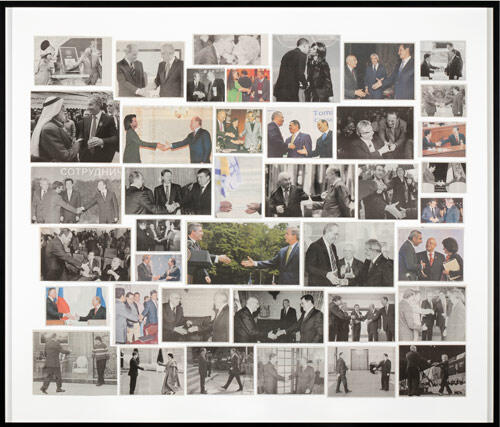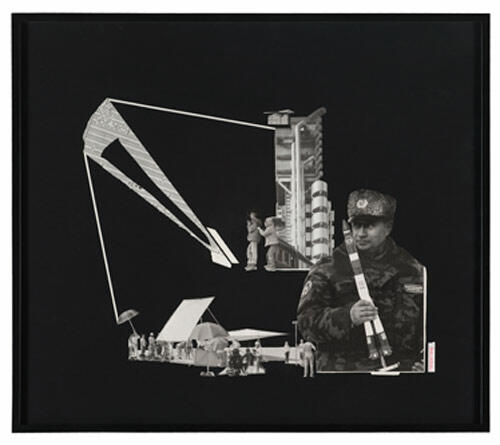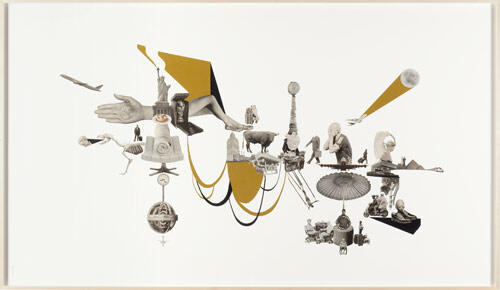Jonathan Hernández
The Invisible Fabric
Among the essays, interviews and articles I received as contributions for the preparation of this brief text on Jonathan Hernández (Mexico, 1972), there appeared, without any explanation, a fragment of a book by Wittgenstein, entitled in its English version, Light and Shadow, A nightly (dream-) experience and a fragment of a letter. In this book, the German philosopher revisits, with some fundamental differences, Plato’s Myth of the Cave, with the aim of reflecting on the relativity of Western culture (or of any culture, for that matter), and on the way in which what really touches us, as spectators of any artistic manifestation, is the clash between genius and the boundaries of culture. Towards the end of the text, when, surprisingly, it reveals itself to be a letter, Wittgenstein adds: “This Friday (2/10) I want to go to Vienna, and I would appreciate your letting me know, by leaving a note at the Kriehubergasse, if you will still be at Neuwaldegg or at the Alleegasse.”

Although there is no direct relationship between this text by Wittgenstein and Jonathan Hernández’s work, the reference to it, and in particular the previous choice evidently made by the author to include it among the material about the artist, is fully justified if we bear in mind that the relationship between different cultures, and above all, the questioning with respect to what can and must be preserved, and therefore inscribed within the sphere of the so-called “high” culture, are central issues in the Mexican artist’s oeuvre. In fact, despite their undeniable philosophical density, these matters are almost always addressed using typically everyday-life materials such as newspaper clips or photographs which have been found or taken by the artist without any great aesthetic concern, revealing an indissoluble intertwining of philosophical thinking and apparently prosaic issues, which is reflected perfectly by the way in which, in the text, Wittgenstein shifts from philosophical arguments to ordinary questions related to his imminent trip to Vienna.
The privileged focus of Jonathan Hernández’s interest is the vertiginous rate at which images are introduced into and disappear from our lives, in particular images which have had enormous repercussion but are, however, extremely fragile, such as the ones that appear in newspapers worldwide. Over the past few years, the artist has been building a huge archive, organized on the basis of recurring typological iconographies (men with their hands covering their faces, smoke screens, political leaders holding their hands up or pointing at something, etc.) in which images are preserved until they eventually converge in works such as the ongoing series Vulnerabilia (2004 -) and Estado vacioso (2010 -). The same pleasure derived from creating small visual poems by juxtaposing images is the point of departure for another series, entitled Couple & Célibataires (2001-2002), in which photographs taken in different parts of the world are presented in pairs, in such a way as to highlight surprising formal correspondences. In this way, the artist creates a small dictionary, a glossary of unsuspected, almost surreal relationships, such as the convergence of the neck of a geisha in a Tokyo shopping mall and a verse engraved on a marble bust featuring some dignitary in a square in Buenos Aires. Of course there is also the possibility that the geisha may not be in Tokyo, and that the square may not located in Buenos Aires. Jonathan Hernández gives no explanation; all we have are the images. Contradicting the convention we are used to, not even the images appropriated from the press have captions; it is up to the viewer to imagine a story and a context for them or, in another possible exegesis, to decide that there is no message, no story to be reconstructed.
Another considerably well-known series of collages, Rongwrong (2005-) seems to justify the latter reading: here the figures have been cut out from their backgrounds and have therefore been decontextualized even more dramatically than in the previously analyzed series; then they have been transferred onto large sheets of white paper where the artist arranges them carefully, creating extremely elegant forms whose ultimate meaning, however, continues to be even more undecipherable. Whereas on the one hand the reference to the modernist tradition of collage becomes more evident, by rendering a univocal and clear reading impossible those works fully reveal their relevance, their intrinsically postmodern character.
Evidently, the absence of clear clues may have the effect of leaving the spectator defenseless, perplexed when faced with the torrent of images and possible meanings, but on the other hand, this challenges him/her to engage in reflection, it incites him/her to find revelations and meaning even in things which are apparently unconnected or out of place, as in the case of the Wittgenstein text referenced above, and which, at first sight, appears to have got mixed up with the works and texts on the artist by mistake, but which actually constitutes the most consistent introduction to his oeuvre (by now it should be evident that the fact that the presence of the mentioned text should have no explanation does in no way denote carelessness but rather responds to the artist’s own strategy). The key to go into Jonathan Hernández’s oeuvre in more depth is, therefore, to bear in mind the premise that, despite appearances, nothing is there by chance and everything is connected as if by an invisible spider’s web. As a small digression, justifiable and even useful in the case of an artist who shows such strong interest in the analogies and antinomies of Post-modernism, it may be worthwhile highlighting the way in which Jonathan Hernández’s oeuvre elicits comparisons and parallelisms with other artists of his generation: the emphasis on the vulnerability of images, for instance, makes it possible to relate the collages featured in Vulnerabilia with the recent series of Polaroid photographs by the Cypriot artist Haris Epaminonda; the Utopian aspiration to create a potentially infinite archive of the everyday finds a counterpoint, in Brazil, in the work of Mabe Bethônico, and the choice of collage allows for a comparison of his work to that of the Croatian David Maljkovic, to name just a few artists among the many that could have been mentioned. If on the one hand these symmetries show the pertinence of Jonathan Hernández’s work, his being in tune with the matters that inform contemporary artistic production in different parts of the world, on the other hand they confirm, above all, the extreme richness of his oeuvre, the impossibility to limit it to a single reading or to attempt to present any interpretation as the definitive one.
-
 Vulnerabilia (casi), 2008-2010. Newspaper collage on cardboard, 37.5 x 43.7 x 1.6 in. Courtesy: Kurimanzutto Gallery
Vulnerabilia (casi), 2008-2010. Newspaper collage on cardboard, 37.5 x 43.7 x 1.6 in. Courtesy: Kurimanzutto Gallery
Collage de recortes de periódico sobre cartulina, 95,2 x 111 x 4 cm. Cortesía: Galería Kurimanzutto..
-
 Wish you were here, 2007. Letters in acrylic, mirror, styrene and mdf. Courtesy: Kurimanzutto Gallery
Wish you were here, 2007. Letters in acrylic, mirror, styrene and mdf. Courtesy: Kurimanzutto Gallery
Letras en acrílico, espejo, estireno y tablero DM. Cortesía: Galería Kurimanzutto.
-
 Rongwrong XXI, 2008. Newspaper collage on cardboard, 32.5 x 37 x 1.4 in. Courtesy: Kurimanzutto Gallery
Rongwrong XXI, 2008. Newspaper collage on cardboard, 32.5 x 37 x 1.4 in. Courtesy: Kurimanzutto Gallery
Collage de recortes de periódico sobre cartulina, 85,2 x 94 x 3,5 cm. Cortesía: Galería Kurimanzutto..
-
 Rongwrong XXV, 2011. Newspaper collage on cardboard, 58 x 99 x 1.9 in. Courtesy: Kurimanzutto Gallery
Rongwrong XXV, 2011. Newspaper collage on cardboard, 58 x 99 x 1.9 in. Courtesy: Kurimanzutto Gallery
Collage de recortes de periódico sobre cartulina, 147,5 x 252,3 x 5 cm. Cortesía: Galería Kurimanzutto..
-
 Vulnerabilia (ver llover), 2008-2010. Newspaper clippings. Variable dimensions Courtesy: Nara Roesler Gallery
Vulnerabilia (ver llover), 2008-2010. Newspaper clippings. Variable dimensions Courtesy: Nara Roesler Gallery
Recortes de periódico. Dimensiones variables. Cortesía Galería Nara Roesler
-
 Espelho (Mirror) 2010. Recycled wood and Peroba wood, 67 x 67 x 67 in. Courtesy: Nara Roesler Gallery
Espelho (Mirror) 2010. Recycled wood and Peroba wood, 67 x 67 x 67 in. Courtesy: Nara Roesler Gallery
Madera reciclada y madera de peroba, 170 x 170 x 170 cm. Cortesía Galería Nara Roesler
-
 Vulnerabilia (ver llover), 2008-2010. Newspaper clippings. Variable dimensions. Courtesy: Nara Roesler Gallery
Vulnerabilia (ver llover), 2008-2010. Newspaper clippings. Variable dimensions. Courtesy: Nara Roesler Gallery
Recortes de periódico. Dimensiones variables. Cortesía Galería Nara Roesler
-
 Jonathan Hernández
Jonathan Hernández
Courtesy / cortesía: Nara Roesler Gallery




